 GEARS AND GEARBOXES GEARS AND GEARBOXES |
 A gear is a rotating machine part having cut teeth, or cogs, which mesh with another toothed part in order to transmit torque. Two or more gears working in tandem are called a transmission and can produce amechanical advantage through a gear ratio and thus may be considered a simple machine. Geared devices can change the speed, torque, and direction of a power source. Gears can be grouped according to their usage types. There are two mains groups of gears according to their axis as vertical and parallel. A gear is a rotating machine part having cut teeth, or cogs, which mesh with another toothed part in order to transmit torque. Two or more gears working in tandem are called a transmission and can produce amechanical advantage through a gear ratio and thus may be considered a simple machine. Geared devices can change the speed, torque, and direction of a power source. Gears can be grouped according to their usage types. There are two mains groups of gears according to their axis as vertical and parallel.
|
 Parallel Axis Gears Parallel Axis Gears |
In this type of configuration the gears are connected to each other in a way that their axis will be parallel to each other.
 Spur Gears : Spur Gears :
Spur gears or straight-cut gears are the simplest type of gear. They consist of a cylinder or disk with the teeth projecting radially, and although they are not straight-sided in form, the edge of each tooth is straight and aligned parallel to the axis of rotation. These gears can be meshed together correctly only if they are fitted to parallel shafts.
 Helical Gears : Helical Gears :
Helical gears offer a refinement over spur gears. The leading edges of the teeth are not parallel to the axis of rotation, but are set at an angle. Since the gear is curved, this angling causes the tooth shape to be a segment of a helix. Helical gears can be meshed in a parallel or crossed orientations. At any instant the load on the helix gear is divided onto the more teeth of the gear, so there will be less deformation within time. Helical gears can be placed in such a way that their axis are in parallel or vertical. The disadvantage of those gears is the repulsive force caused by the helix structure of the teeth. This situation increases the frictional force between the teeth, to reduce this effect the teeth of the helical gears should be oiled.
 Double Helical Gears : Double Helical Gears :
These are the gears that look like two mirrored helical gears joined together. The repulsive force for double helical gears are less than that of helical gears, since the gears are in V shape and the effect of the repulsive force is divided on each of the two sections of the V shaped teeth. Therefore, the resulting deformative effect of the repulsive force is reduced.
|
 Vertical Axis Gears Vertical Axis Gears |
These gears are positioned in a way that their shaft axis are in vertical position..
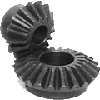 Bevel Gears : Bevel Gears :
The teeth of bevel gears may be like spur gears or they may be cut in a variety of other shapes.
Spur conical gears are used to transfer the motion within the shafts with intersecting axis. The degree between the shafts can be any degree but 0 and 180. The gears having same number of teeth and a degree of 90 between their shafts are called miter gears.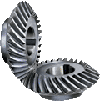
Spiral bevel gears have teeth that are curved along the tooths length and set an angle. Zerol bevel gear teeth are curved along their length, but not angled. Spiral gears have the advantages and disadvantages similar to helical gears.
Crown Gears :
Crown gears or contrate gears are a particular form of bevel gear whose teeth project at right angles to the plane of the wheel; in their orientation the teeth resemble the points on a crown. A crown gear can only mesh accurately with another bevel gear, although crown gears are sometimes seen meshing with spur gears.
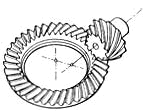 Hypoid Gears : Hypoid Gears :
Hypoid gears are like the spiral bevel gears, the only difference is that the shaft axes of hypoid gears do not intersect.These gears are almost designed to operate with shafts at 90 degrees. Hypoid gears combine the rotational motion and high tooth pressure of the spiral conic gears and the sliding motion of worm gears. They are most commonly found driving mechanical differentials; which are normally straight cut bevel gears; in motor vehicle axles.
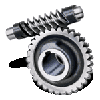 Worm Gear : Worm Gear :
Worm gear resemble screws. These gears are usually meshed with a spur gear or a helical gear, that is called the gear, wheel or worm wheel. Worm gears are a way in order to achieve a high torque, low spped gear ratio. One disadvantage of worm gears is the potential for considerable sliding action, that leads to a low efficiency. In the systems that contain worm gears, it is possible that the worm wheel to turn the adjacent gear infinitely. However, the adjacent gear cannot turn the worm wheel.
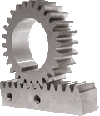
Rack and Pinion :
This gear system consists of two part that are a toothed rod (rack) and a gear that moves on the rack (pinion). These gear systems are used in automobiles to convert the rotation of the steering wheel into the left-to-right motion of the tie rods.
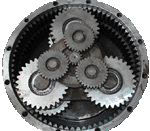 Planet Gears : Planet Gears :
The planet gears are one of the most complicated arrangement of gears. These systems basically consist of one inner gear, a gear in the middle and a few gears (2,3,4) around that. The planet gear systems can be used to obtain different shaft turning speeds.
|
 Gearboxes Gearboxes |
Gearboxes are used to change the speed and torque of motors. The number, the size, the arrangements and number of teeth of the gears used in a gearbox are the factor that are affecting the exit speed and torque change of the motors.
For example; a motor that has a gearbox with a reduction ratio of 100:1 has a 100 times reduced speed and 100 times increased torque.
The quality of the gears in the gearboxes are important for the lifetime of the gearbox. The teeth of the gears may be eroded within time. To reduce the erosion the gears should be oiled periodically.
|
References:
Mechatronic Sourcebook, Newton C. Braga, Thomson Delmar Learning |
|

